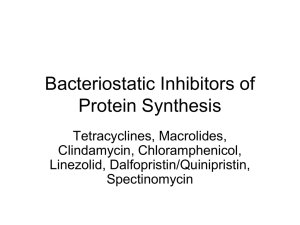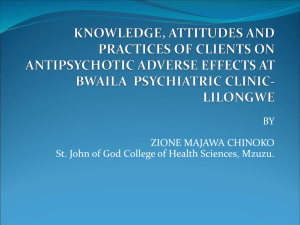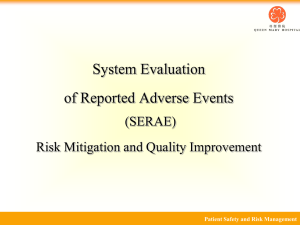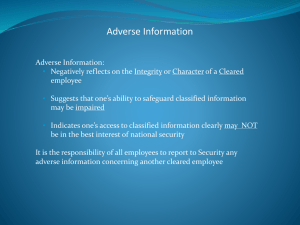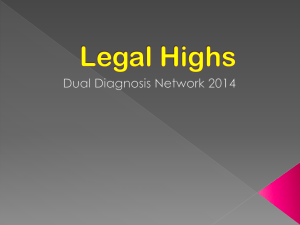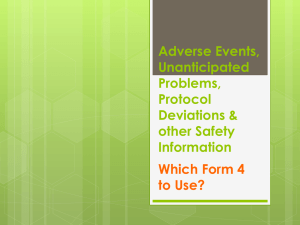CWIC Module: Pharmacology presentation
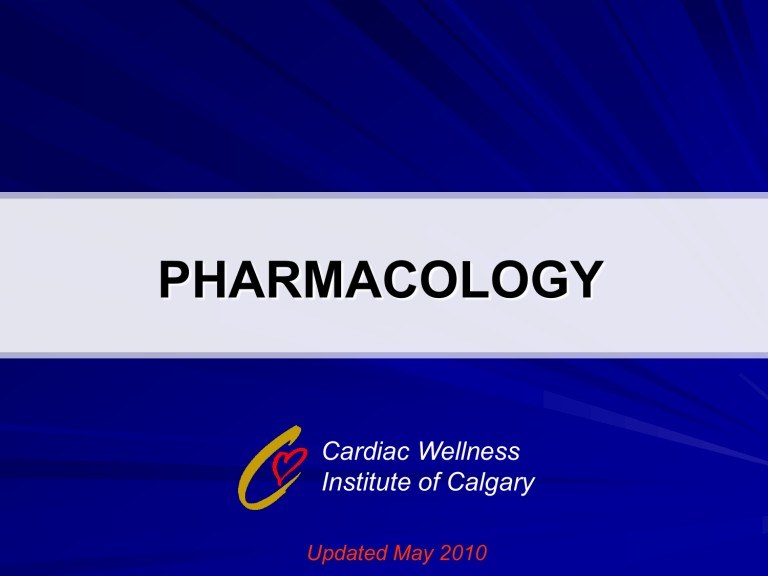
PHARMACOLOGY
Cardiac Wellness
Institute of Calgary
Updated May 2010
Material to be Covered
ACSM’s Resource Manual for Guidelines for
Exercise Testing and Prescription ( 6 th edition)
− Chapter 6 (pg. 115-116)
− Chapter 8 (pg. 145-147)
− Chapter 38 (pg. 622-624)
ACSM’s Guidelines for Exercise Testing and
Prescription (8 th edition)
− Appendix A (pg. 274-291)
Pharmacology for Nursing Care 5 th ed
.
Cardiac Medications
Beta Blockers
Prescribed for: Angina, Myocardial Infarction
(MI), arrhythmia, essential tremors (shaking), migraines
Mechanism of Action :
– Competitively block ß-adrenergic receptors
–
–
ß
1 receptors - cardiac stimulation
ß
2 receptors - vascular and bronchial smooth muscle dilation
– Cardioselective ß-blockers (blocks ß
1 not ß
2
)
Beta-Blockers
Hemodynamic Effects:
– myocardial O
2 time) demand ( HR, diastolic filling
– HR, BP, myocardial contractility (rest & ex)
– ischemia
Exercise Capacity:
–
–
patients with angina
or
patients without angina
– GXT for ischemia - false negative
Beta-Blockers
Adverse Effects:
– BP - lightheaded or dizzy
– Coronary artery vasoconstriction/worsening spasm
– Exacerbate acute Congestive Heart Failure (CHF)
– claudication pain in people with Peripheral Arterial
Disease (PAD); cold hands & feet
– Precipitation/worsening of bronchospasm
– Bradycardia or AV block
– Mask S/S of hypoglycemia in diabetes
– Fatigue, depression, insomnia, vivid dreams
– triglycerides, HDL-C
Beta-Blockers
Common ß-blockers
– Metoprolol/Lopressor
– Atenolol/Tenormin
– Bisoprolol/Monocor
Nitrates
Prescribed for: Angina & CHF
Mechanism of Action:
– Direct relaxation of vascular smooth muscle
– myocardial O
2 supply by dilating collateral arteries
(not atherosclerotic arteries)
– preload & afterload, therefore
end diastolic volume
Nitrates
Hemodynamic Effects:
–
–
–
Rest HR (Baroreceptor-mediated tachycardia)
or
Ex HR
Rest BP & or
Ex BP
– time to ischemia
–
–
myocardial O
2 consumption
May coronary blood flow d/t collateral flow or
ventricular diastolic pressure
– Prevention of spasm
Nitrates
Routes of Administration:
– Sublingual
– Oral
– IV
– Transdermal
Use:
– PRN or prophylactically
Nitrate Tolerance
– 10 - 12 hour NTG-free interval
Nitrates
Adverse Effects:
– Headache
– Dizziness or lightheaded
– Weakness
– HR
– Flushed face
– Skin irritation
Not for use with drugs such as Viagra, Cialis,
Levitra etc. (Hypotension!)
Nitrates
Common Nitrates
–
–
–
Nitroglycerin spray
Isosorbide mononitrate/Imdur
Nitro-Dur (patch)
Calcium Channel Blockers
(CCBs)
Prescribed for: Angina, MI, spasm, hypertension
Mechanism of Action:
– Selective blockade of transmembrane calcium flow
Limits calcium entry into cardiac & smooth muscle cells
OR
Relaxation of vascular smooth muscle
CCBs
No direct effect on myocardial contractility or
SA/AV node conduction
– Most CCBs work only on arterioles
Exception : Diltiazem & Verapamil
– HR
– AV node conduction
CCBs
Hemodynamic Effects:
–
–
–
or
Rest HR & Ex HR
BP
ischemia
Exercise Capacity:
–
–
in patients with angina
in patients without angina
CCBs
Adverse Effects: (vary with each medication)
–
–
–
–
–
–
–
–
–
–
CHF
Hypotension
Bradycardia
Dizzy/syncopal
Flushing
Swelling
Headaches
Constipation
Dry mouth
Nausea
CCBs
Common Calcium Channel Blockers
– Amlodipine/Norvasc
– Diltiazem/Cardizem/Tiazac
– Verapamil/Isoptin
– Nifedepine/Adalat
Angiotensin Converting
Enzyme (ACE) Inhibitors
Prescribed for: HTN, CHF, MI and Diabetic nephropathy
Mechanism of Action:
– ACE Inhibitors block the reaction of angiotensin I to angiotensin II, which is a potent vasoconstrictor.
ACE Inhibitors
Hemodynamic Effects:
– Rest & Ex HR
– Rest & Ex BP
– or prevent ventricular remodeling
Exercise Capacity:
–
–
or in patients with CHF
in patients without CHF
ACE Inhibitors
Adverse Effects:
– Dry cough
– Kidney failure
– Swelling of face, tongue or lips (angioedema)
– BP (dizziness or lightheaded)
Common ACE Inhibitors
– Ramipril/Altace
– Enalapril/Vasotec
– Fosinopril/Monopril
– Lisinopril/Prinivil/Zestril
Angiotensin II Receptor
Blockers (ARBs)
Prescribed for: HTN, CHF and Diabetic nephropathy
Mechanism of Action:
– ARBs block access of angiotensin II to its receptors
Results in vasodilation and reduced secretion of aldosterone and vasopressin, ultimately reducing
BP and myocardial workload
ARBs
Hemodynamic Effects:
– Rest & Ex HR
– Rest & Ex BP
Exercise Capacity:
– No effect
Adverse Effects:
– Headache
– Angioedema
– Low Blood Pressure
Common ARBs
–
–
–
Irbesartan/Avapro
Losartan/Cozaar
Valsartan/Diovan
ARBs
Diuretics
Prescribed for: HTN, CHF, Peripheral edema
Mechanism of Action:
– renal secretion of salt and water
– Inhibits sodium re-absorption at various sites of the nephron
– intravascular volume & edema
Diuretics
Hemodynamic Effects:
–
–
–
in Rest & Ex HR
or in Rest & Ex BP
, PVCs or false positive on ECG
Exercise Capacity:
– No change
Diuretics
Adverse Effects:
– Electrolyte abnormalities
–
Hyper/Hypokalemia
LDL-C & triglycerides
– Hypovolemia
Common Diuretics
– Esidrix/Hydrochlorothiazide (HCTZ)
– Furosemide/Lasix
– Spironolactone/Aldactone
Digitalis
Prescribed for : CHF and Atrial Arrhythmia
Mechanism of Action:
– Inhibits Na + -K + -ATPase
Limits ionic movement across myocardial cell membrane
– Positive inotropic effect ( myocardial contractility)
Digitalis
Hemodynamic Effects:
– Sinus rhythm: HR
–
–
Afib or CHF: Rest & Ex HR
Rest & Ex BP
– “Dig effect”
Non-specific ST-T changes and false positive exercise ECG
Exercise Capacity:
–
–
in patients with Afib or CHF
in others
Digitalis
Adverse Effects:
– Toxicity
Visual and neurological symptoms
Arrhythmias
Common Digitalis Medications
– Lanoxin/Digoxin
Anti-Arrhythmic Agents
Classified by electrophysiological effect:
Class I :
– conduction velocity, excitabilty & automaticity
– peripheral vasodilation
– Prolong QRS or Long QT Syndrome
Common Class I Meds
– Lidocaine/Xylocaine
– Propafenone/Rhythmol
Anti-Arrhythmic Agents
Class II :
ß-Blockers
Class III :
– Mechanism of Action:
Blocks Na + channels
Negative chronotropic effect
conduction
myocardial O
2 demand
Delays repolarization
Anti-Arrhythmic Agents
Class III (con’t)
– Hemodynamic Effect:
Rest & Ex HR
Rest & Ex BP
ECG
Exercise Capacity:
No effect
Adverse Effects:
arrythmias
Bradycardia/AV block
Hypotension
Photosensitivity
Dermatological, GI,
Hepatic or thyroid
Electrolyte disturbance abnormalities
Anti-Arrhythmic Agents
Class III ( con’t)
– Common Class III Meds
Amiodarone/Cordarone
Sotalol/Betapace
Class IV :
– Calcium Channel Blockers
Platelet Aggregation Inhibitors
Mechanism of Action:
– Different for each med
–
–
ASA:
production of thromboxane A
2
Plavix:
binding of ADP to its platelet receptor
Hemodynamic Effect:
– No effect
Exercise Capacity:
– No effect
Platelet Aggregation Inhibitors
Adverse Effects:
– Bruise easily
– Bleeding gums
– Cuts and nicks bleed longer
– GI upset
Common Platelet Aggregation Inhibitors
– Clopidigrel/Plavix
– Ticlopidine/Ticlid
– Aspirin/Asaphen/ASA
Anticoagulants
Prescribed for: Venous thrombosis, pulmonary embolism, Afib with embolization, prophylaxis after MI
Mechanism of Action:
– Coumadin : inhibit synthesis of Vit K dependant clotting factors
– Heparin : prevents progression of existing clot by inhibiting any further clotting processes
Anticoagulants
Hemodynamic Effects:
– No effect
Exercise Capacity:
– No effect
Adverse Effects:
– Bleeding
– Bruising
– GI bleed
Other Commonly Used
Medications
Diabetes Management
Oral hypoglycemic agents
– Used in Type 2 diabetes only
– Used in conjunction with diet and exercise
1 & 2) Sulfonylureas & Meglitinides
– Mechanism of Action: stimulates release of insulin from pancreatic islets to lower blood glucose
– Adverse Effects: Hypoglycemia
– Common Medications
Glyburide/DiaBeta
Repaglinide/Gluconorm
Diabetes
3) Alpha-glucosidase Inhibitors
Mechanism of Action:
– Reduce the rate of digestion of CHO, primarily lowering postprandial glucose concentrations
Adverse Effects:
– Flatulance
– Cramps
– Abdominal distension, diarrhea
– Liver dysfunction
– *** Minimal chance of hypoglycemia
Diabetes
4) Biguanides
Mechanism of Action:
– production of glucose in the liver; glucose utilization at the muscle
Adverse Effects:
– Lactic acidosis, nausea, diarrhea, loss of appetite
– *** no risk of hypoglycemia
Metformin/Glucophage
Diabetes
5) Thiazolidinediones (Glitazones)
Mechanism of Action:
– insulin resistance; production of glucose by liver,
glucose uptake by muscle
Adverse Effects:
–
–
–
–
–
Expands blood volume; weight gain, edema
Headache
Sinusitis
Myalgia
LDL-C & HDL-C, Triglycerides
Pioglitazone/Actos
COPD Management
1) Glucocorticosteroids
Prescribed for allergy symptoms and asthma
Mechanism of Action: suppresses inflammation
Adverse Effects:
– Hoarseness, difficulty speaking, slow growth in children, increased risk of cataracts, osteoporosis & peptic ulcer disease
Fluticasone Propionate/Flovent
COPD
2) Leukotriene Receptor Antagonists
To prevent symptoms caused by asthma, chronic bronchitis, emphysema and other lung diseases.
Mechanism of Action:
– Block cysteinyl leukotrienes from binding to their receptors, preventing bronchoconstriction and mucous production
Adverse Effects:
– Generally well tolerated
Monteluekast Sodium/Singulair
COPD
3) Beta
2
-adrenergic Stimulants
To prevent symptoms caused by asthma, chronic bronchitis, emphysema and other lung diseases.
Mechanism of Action:
– Selective activation of Beta
2
-adrenergic receptors to promote bronchodilation and relieve bronchospasm.
Adverse Effects:
– ß
1
–adrenergic receptors in the heart could be stimulated causing Tachyarrhythmias and Angina
– Musculoskeletal tremors
Albuterol/Ventolin
COPD
4) Anticholinergics
To prevent symptoms caused by asthma, chronic bronchitis, emphysema and other lung diseases.
Mechanism of Action:
– Promotes bronchodilation
Adverse Effects:
– Dry mouth
– Irritation of pharynx
Atrovent/Ipratropium Bromide
Lipid Management
1) HMG CoA Reductase Inhibitors (STATINS)
Mechanism of Action:
– cholesterol production
– Increase number of LDL receptors on hepatocytes, enhancing the elimination of LDL from the blood
Beneficial Cardiovascular Actions :
– LDL, HDL, Promote plaque stability
– Improve abnormal endothelial function; enhanced vessel dilation & reduce risk of thrombosis
Lipids
Adverse Effects:
– Generally well tolerated
– Headache; rash; GI disturbance; Myopathy
(Rhabdomyolysis)
Common Medications:
– Atorvastatin/Lipitor
– Simvastatin/Zocor
– Rosuvastatin/Crestor
– Pravastatin/Pravachol
Lipids
2) Ezetimibe/Ezetrol
TC, LDL, Trigs & can HDL
Mechanism of Action:
– Blocks absorption of dietary and bile-secreted cholesterol
Adverse Effects:
– Generally well tolerated
Lipids
3) Fibric Acid Derivatives (FIBRATES)
Most effective for
Trigs &
HDL
Mechanism of Action:
– Activate receptors to accelerate the clearance of
VLDLs, and thereby reduce levels of TGs
Adverse Effects:
– Generally well tolerated
– Rashes and GI disturbances
Gemfibrizol/Lopid
Lipids
4) Nicotinic Acid
Mechanism of Action: VLDL production, therefore LDL levels and HDL levels
Adverse Effects: flushing, GI disturbances, gallstones, hepatotoxicity
Common Medications:
– Niacin/Niaspan

